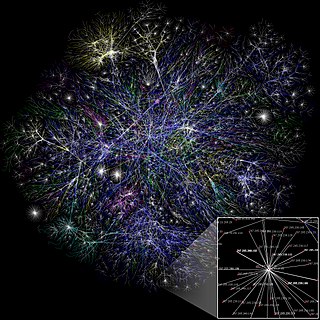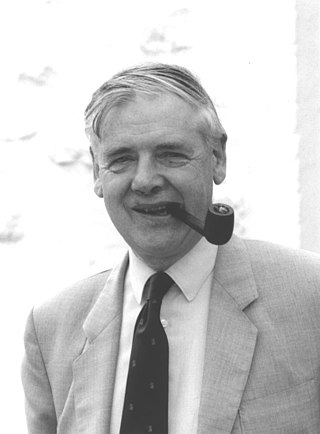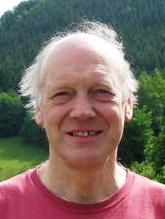
In statistical physics and mathematics, percolation theory describes the behavior of a network when nodes or links are added. This is a geometric type of phase transition, since at a critical fraction of addition the network of small, disconnected clusters merge into significantly larger connected, so-called spanning clusters. The applications of percolation theory to materials science and in many other disciplines are discussed here and in the articles Network theory and Percolation.

In physics, chemistry, and materials science, percolation refers to the movement and filtering of fluids through porous materials. It is described by Darcy's law. Broader applications have since been developed that cover connectivity of many systems modeled as lattices or graphs, analogous to connectivity of lattice components in the filtration problem that modulates capacity for percolation.

In mathematics, random graph is the general term to refer to probability distributions over graphs. Random graphs may be described simply by a probability distribution, or by a random process which generates them. The theory of random graphs lies at the intersection between graph theory and probability theory. From a mathematical perspective, random graphs are used to answer questions about the properties of typical graphs. Its practical applications are found in all areas in which complex networks need to be modeled – many random graph models are thus known, mirroring the diverse types of complex networks encountered in different areas. In a mathematical context, random graph refers almost exclusively to the Erdős–Rényi random graph model. In other contexts, any graph model may be referred to as a random graph.

Béla Bollobás FRS is a Hungarian-born British mathematician who has worked in various areas of mathematics, including functional analysis, combinatorics, graph theory, and percolation. He was strongly influenced by Paul Erdős from the age of 14.

John Michael Hammersley, was a British mathematician best known for his foundational work in the theory of self-avoiding walks and percolation theory.

David George Kendall FRS was an English statistician and mathematician, known for his work on probability, statistical shape analysis, ley lines and queueing theory. He spent most of his academic life in the University of Oxford (1946–1962) and the University of Cambridge (1962–1985). He worked with M. S. Bartlett during World War II, and visited Princeton University after the war.

The contact process is a stochastic process used to model population growth on the set of sites of a graph in which occupied sites become vacant at a constant rate, while vacant sites become occupied at a rate proportional to the number of occupied neighboring sites. Therefore, if we denote by the proportionality constant, each site remains occupied for a random time period which is exponentially distributed parameter 1 and places descendants at every vacant neighboring site at times of events of a Poisson process parameter during this period. All processes are independent of one another and of the random period of time sites remains occupied. The contact process can also be interpreted as a model for the spread of an infection by thinking of particles as a bacterium spreading over individuals that are positioned at the sites of , occupied sites correspond to infected individuals, whereas vacant correspond to healthy ones.

Olav Kallenberg is a Swedish-American mathematician, working in all areas of probability theory. He is especially known for his work on random measures and probabilistic symmetries, and for his graduate-level textbooks and monographs. Since 2018 he is an Emeritus Professor of Mathematics at Auburn University, AL.

Peter Gavin Hall was an Australian researcher in probability theory and mathematical statistics. The American Statistical Association described him as one of the most influential and prolific theoretical statisticians in the history of the field. The School of Mathematics and Statistics Building at The University of Melbourne was renamed the Peter Hall building in his honour on 9 December 2016.

David Williams FRS is a Welsh mathematician who works in probability theory.

Harry Kesten was a Jewish American mathematician best known for his work in probability, most notably on random walks on groups and graphs, random matrices, branching processes, and percolation theory.
The Hammersley–Clifford theorem is a result in probability theory, mathematical statistics and statistical mechanics that gives necessary and sufficient conditions under which a strictly positive probability distribution can be represented as events generated by a Markov network. It is the fundamental theorem of random fields. It states that a probability distribution that has a strictly positive mass or density satisfies one of the Markov properties with respect to an undirected graph G if and only if it is a Gibbs random field, that is, its density can be factorized over the cliques of the graph.
János Komlós is a Hungarian-American mathematician, working in probability theory and discrete mathematics. He has been a professor of mathematics at Rutgers University since 1988. He graduated from the Eötvös Loránd University, then became a fellow at the Mathematical Institute of the Hungarian Academy of Sciences. Between 1984–1988 he worked at the University of California, San Diego.

James Ritchie Norris is a mathematician working in probability theory and stochastic analysis. He is the Professor of Stochastic Analysis in the Statistical Laboratory, University of Cambridge.
Rollo Davidson was a probabilist, alpinist, and Fellow-elect of Churchill College, Cambridge, who died aged 25 on Piz Bernina. He is known for his work on semigroups, stochastic geometry, and stochastic analysis, and for the Rollo Davidson Prize, given in his name to early-career probabilists.

Sourav Chatterjee is an Indian Bengali mathematician from West Bengal, specializing in mathematical statistics and probability theory. Chatterjee is credited with work on the study of fluctuations in random structures, concentration and super-concentration inequalities, Poisson and other non-normal limits, first-passage percolation, Stein's method and spin glasses. He has received a Sloan Fellowship in mathematics, Tweedie Award, Rollo Davidson Prize, Doeblin Prize, Loève Prize, and Infosys Prize in mathematical sciences. He was an invited speaker at the International Congress of Mathematicians in 2014.
James Anthony Dominic Welsh was an English mathematician and emeritus professor of Oxford University's Mathematical Institute. He was an expert in matroid theory, the computational complexity of combinatorial enumeration problems, percolation theory, and cryptography.

Gordon Douglas Slade is a Canadian mathematician, specializing in probability theory.

Ioannis Kontoyiannis is a Greek mathematician and information theorist. He is the Churchill Professor of Mathematics of Information with the Statistical Laboratory, in the Department of Pure Mathematics and Mathematical Statistics, of the University of Cambridge. He is also a Fellow of Darwin College, Cambridge, and Chairman of the Rollo Davidson Trust.

The bunkbed conjecture is a statement in percolation theory, a branch of mathematics that studies the behavior of connected clusters in a random graph. The conjecture is named after its analogy to a bunk bed structure. It was first posited by Pieter Kasteleyn in 1985. A preprint giving a proposed counterexample to the conjecture was posted on the arXiv in October 2024 by Nikita Gladkov, Igor Pak, and Alexander Zimin.















